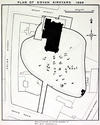 The place name Govan has been used in many forms throughout history and is generally accepted as having been derived from the Celtic "Gowan", or Welsh "Gofan", signifying "a smith". Accordingly, Govan is "the land of the smiths". Its coat of arms, established in 1864, is appropriately Nihil Sine Labore (Nothing Without Work).
The place name Govan has been used in many forms throughout history and is generally accepted as having been derived from the Celtic "Gowan", or Welsh "Gofan", signifying "a smith". Accordingly, Govan is "the land of the smiths". Its coat of arms, established in 1864, is appropriately Nihil Sine Labore (Nothing Without Work).
 "The oldest of existing records point to a ford …there is every probability that the road leading to it was a Roman way," wrote Brotchie in 1905. Govan's humble origins have been traced to pre-Christian days, although its popular history begins around 565AD when Saint Constantine founded his monastery on the site of the present Govan Old Parish Church. The next significant account was around 1147-53 when King David, in restoring the fallen bishopric of Glasgow, embraced Govan and Partick within its bounds including the islands between "Guven and Pertye or Perthec". Since it was about this time that Govan was also made a prebend (associated church) of Glasgow Cathedral, this explains why the parish extended to both sides of the river.
"The oldest of existing records point to a ford …there is every probability that the road leading to it was a Roman way," wrote Brotchie in 1905. Govan's humble origins have been traced to pre-Christian days, although its popular history begins around 565AD when Saint Constantine founded his monastery on the site of the present Govan Old Parish Church. The next significant account was around 1147-53 when King David, in restoring the fallen bishopric of Glasgow, embraced Govan and Partick within its bounds including the islands between "Guven and Pertye or Perthec". Since it was about this time that Govan was also made a prebend (associated church) of Glasgow Cathedral, this explains why the parish extended to both sides of the river.
 For the next four hundred years or so, since the church was the mainspring of the community, references were mostly to ecclesiastical affairs as Govan remained a veritable "sleepy hollow" whose main industries were agriculture and salmon fishing. However during that time it was also developing and its position, opposite the meeting point of the rivers Kelvin and Clyde, led to the establishment of the first Govan Ferry which facilitated the crossing of the river to other parts of the parish.
For the next four hundred years or so, since the church was the mainspring of the community, references were mostly to ecclesiastical affairs as Govan remained a veritable "sleepy hollow" whose main industries were agriculture and salmon fishing. However during that time it was also developing and its position, opposite the meeting point of the rivers Kelvin and Clyde, led to the establishment of the first Govan Ferry which facilitated the crossing of the river to other parts of the parish.